Integrated Cooperation in Implementing Firearm Deactivation Capabilities: Bosnia and Herzegovina
By Lieutenant Colonel Geir P. Novik [ Norwegian Defence Research Establishment ]
CISR JournalThis article is brought to you by the Center for International Stabilization and Recovery (CISR) from issue 27.3 of The Journal of Conventional Weapons Destruction available on the JMU Scholarly Commons and Issuu.com.
Many of the illegal firearms used for terrorist and criminal activities throughout Europe originate from the Balkan region and have previously been legally exported and sold as deactivated firearms. However, due to variations in the quality of deactivation standards and verification processes, many deactivated firearms can easily be reactivated into fully functional military weapons. To prevent the illegal reactivation of additional weapons, new guidelines regarding deactivation standards and techniques have been introduced, thus ensuring that deactivated firearms are rendered irreversibly inoperable. Within the framework of the European Union Force Bosnia and Herzegovina (EUFOR), a training program regarding the deactivation of firearms has been developed and implemented by the Armed Forces of Bosnia and Herzegovina (AFBiH).
Challenges of Inharmonious Deactivation Standards
Numerous European countries have witnessed an increase in lethal gun violence during the last decade, precipitating concerns that an arms race among drug criminals and the increased availability of illegal firearms could generate even more crime and gun violence.1 According to Project TARGET, an EU-funded research project that aims to determine the impact of gun trafficking on gun violence in the European Union (EU), some higher-level criminals appear to have unlimited access to firearms, including military-grade firearms, through the smuggling of conflict legacy weapons and the trafficking of reactivated firearms.2 According to the European Union Agency for Law Enforcement Cooperation,3 these illegal weapons primarily originate from the Western Balkans and the former Soviet Union; one of the primary sources of such weapons is the circulation of previously decommissioned and deactivated weapons that are reactivated.
Such reactivation involves illegally restating a deactivated firearm (i.e., a firearm that has been rendered inoperable) to an operable condition. This is generally made possible through inadequate national deactivation standards (i.e., insufficiently invasive or permanent) or through sub-standard deactivation processes.4,5 Firearms that were improperly deactivated have been known to be reactivated and used in shootings throughout Europe.6,7 To address this escalating problem involving the reactivation of formerly deactivated firearms, the European Commission has established a set of common guidelines regarding deactivation standards and techniques to ensure that deactivated firearms are rendered irreversibly inoperable (e.g., Regulation ((EU)) 2018/337).8 It is anticipated that the implementation of such EU regulations has tackled the source of the problem of deactivated firearms that could easily be reactivated.
However, in practice, many countries still apply different deactivation criteria depending on the extent of the deactivation process to which such firearms have been subjected. Nations have varying deactivation standards and specifications; some countries have more rigorous standards while others have older or outdated deactivation specifications, enabling a later restoration of the weapons to full working order.9
To ensure that deactivated firearms are rendered irreversibly inoperable, thereby guaranteeing that they are not subsequently used in illicit firearms trafficking and criminal or terrorist activities, it is necessary to implement appropriate firearm deactivation standards.
Surplus Weapons in Bosnia and Herzegovina
When the Yugoslav Wars in the Balkans ended in 2001, large quantities of weapons were left in poorly managed stockpiles and in the hands of the military and police, as well as militias and civilians. Subsequently, the Balkans became an acknowledged source of guns that had been diverted from official stockpiles for illicit use in Europe and elsewhere.10 Even in Bosnia and Herzegovina, challenges related to unregistered small arms and light weapons (SALW) persist nearly three decades after the end of the war. Some of these weapons are located at identified depots under military control, while others are at locations that remain unknown, and many continue to evade identification and registration.11
However, through bilateral and regional defense cooperation and with assistance from the international community, the AFBiH has made immense inroads toward identifying, marking, storing, safeguarding, and maintaining their weapon inventories according to international standards. A vital part of this assistance has involved the cooperation and joint training of AFBiH and European Union Force Bosnia and Herzegovina (EUFOR) units, as well as case-specific training for the AFBiH, such as that organized by EUFOR Mobile Training Teams (MTT). Within the framework of such an MTT, the Swiss military has supported AFBiH with time-limited, specific training sequences in ammunition and weapons stockpile management since 2011. Through this joint venture, the AFBiH and the EUFOR MTT are currently in the process of establishing a highly competent training cell, namely the Ammunition Weapon Explosive Training Cell (AWE TC). This cell is subordinate to the AFBiH Training Doctrine Command (TRADOC).
As a result of this cooperation, the AFBiH has identified tens of thousands of weapons of different calibers; these weapons have been declared non-prospective, meaning that they serve as surplus for the AFBiH.12 The AFBiH now aims to reduce the surplus in a transparent and controlled manner and to establish a sustainable life cycle for the fixed stockpile.13 By deliberating about alternative methodologies for stock reduction, and in light of the global challenges posed by illicit firearms trafficking and the usage of reactivated deactivated firearms, the special ammunition and weapons advisor (SAWAD) to COM EUFOR and the EUFOR MTT identified a need to develop the AFBiH’s capability to deactivate firearms according to international standards. As a result, such firearms can be rendered irreversibly inoperable, thus virtually eliminating the risk that they may be illegally reactivated and used for criminal activity.
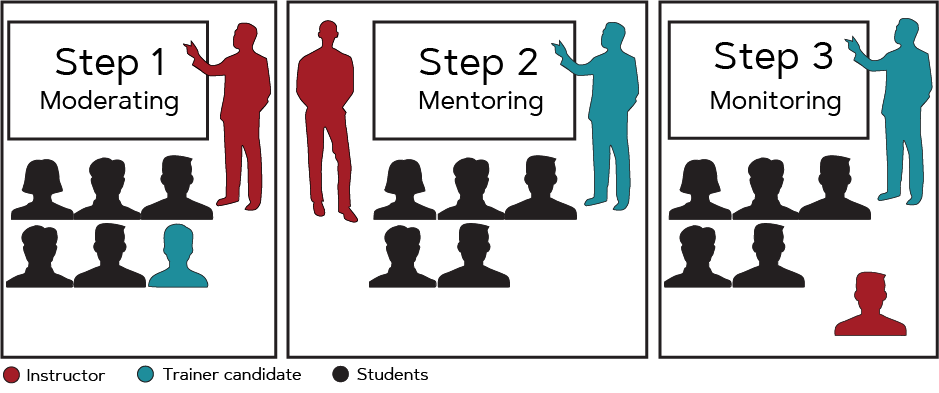
Collaborating to Develop an EU Standards-Based Training Program
The Multinational Small Arms and Ammunition Group (MSAG) is an apolitical, informal, multinational assembly of like-minded states that undertakes, at the discretion of the member states, the development of any SALW/Conventional Ammunition (CA) related standard operative procedures and training programs deemed necessary to improve the quality of the efforts made in the field of SALW/CA.
Its aim is to enhance the development of a capacity on physical security and stockpile management (PSSM), exchange best practices with regards to SALW/CA, and orchestrate destruction and disposal in order to reduce accidents and the number of SALW in circulation.
Through the framework of the Multinational Small Arms and Ammunition Group (MSAG), the Swiss MSAG representative presented the status of the current SALW operations in Bosnia and Herzegovina and highlighted the necessity to build the capability of the AFBiH in relation to SALW deactivation according to the current EU regulations. As an MSAG member state, Norway offered its assistance in developing and implementing a suitable course program; through a bilateral agreement between the Norwegian Defence Staff and EUFOR MTT, the formalities for a cooperation were established.
At a workshop led by the EUFOR MTT in 2019, the final details for the course were agreed upon, and it was determined that the course program would be in accordance with the 3M principle, encompassing moderating (train the trainer), mentoring (coach the trainer), and monitoring (observe the trainer), thereby enabling the AFBiH to both deactivate firearms according to EU regulations and to maintain a sustainable work pool by independently overseeing the future training of instructors and deactivation specialists. It was also decided to invite SALW specialists from the Swiss Armed Forces Logistics Organisation (LBA) to support the implementation of the course, which later proved to be a major asset to the Norwegian instructors.
Since marking and registration (M&R) is an integral part of the deactivation process, it was pragmatic to include the HALO Trust (HALO) in both the lecture regarding the M&R and the physical marking of unregistered weapons that enter the deactivation process and the final marking of the deactivated weapons according to EU requirements. At the time, HALO had collaborated with EUFOR and AFBiH since 2017 to mark and register the state military stockpile. Through support and funding from several entities, including the German Federal Foreign Office, the United Kingdom, and the Norwegian Ministries of Defense, as well as the United Nations Trust Facility Supporting Cooperation on Arms Regulation (UNSCAR), HALO had successfully marked and registered over 60,000 assorted SALW of over 280 different types.14
By early 2020, much of the preparation work was about to be finalized and was on track for the first deactivation course that was scheduled to take place later that year. However, this would not occur for another two years due to the outbreak of the COVID-19 pandemic.
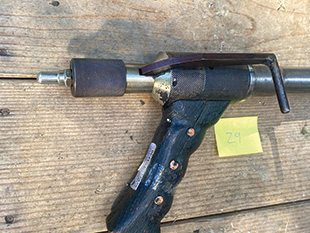
Challenges encountered: A lack of conformity to traditional definitions of firearm types required comprehensive technical knowledge and a thorough understanding of the applicable regulations. Courtesy of Geir P. Novik.
Implementing the Training Program
After two years of continuous postponements, the first train-the-trainer course for the AFBiH was conducted in June 2022 at the AWE TC at the Travnik barracks in central Bosnia and Herzegovina. In this week-long course, twelve highly motivated and skilled members of the AFBiH participated in the training. Out of the twelve, nine participants successfully completed the training and were certified as deactivation qualified specialists. Of these nine participants, six potential trainers were also identified to be selected for the second part of the 3M program, which was to be conducted as an integrated part of the second deactivation course.
In September 2022, the six trainers selected in the June training received an additional one-week course package that included theoretical and practical instruction regarding how to conduct lectures, in addition to advanced deactivation specialist training. This included further teaching and practical exercises in specialized craftsmanship, as well as a comprehensive theoretical introduction to the specifics of the foundational regulations. This would help to ensure that the deactivation process was not only compliant with the applicable regulations, but also that the quality of the workmanship denotes that the physical appearance of the deactivated firearms was preserved. For aesthetic and commercial purposes, retaining the appealing physical appearance of the deactivated firearms will understandably increase the value of a weapon designated for museums, the film industry, or private collectors. All the personnel selected for this training performed outstandingly, and all six were certified as deactivation trainers.
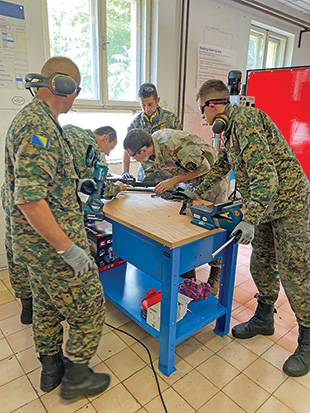 |
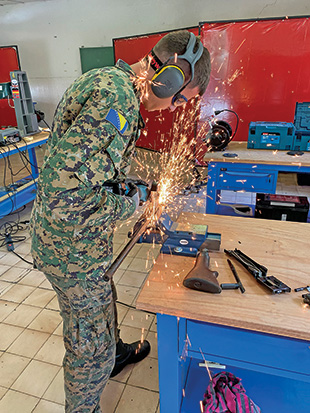 |
| A deactivation team from the program deliberating on the deactivation procedures with support from the Swiss SALW expert. Courtesy of Geir P. Novik. | One of the course participants, a member of the AFBiH, in the process of deactivating an MG 34 general-purpose machine gun, in accordance with Regulation (EU) 2018/337. Courtesy of Geir P. Novik. |
By this time, HALO had terminated their involvement in M&R, and Norwegian People’s Aid (NPA) assumed the responsibilities for M&R in Bosnia and Herzegovina. Supported by Norway, NPA initiated their work as early as 1996, marking their presence as the first civilian organization working in Bosnia and Herzegovina after the end of the war.15 Thankfully, collaboration continued with NPA introducing the students to the practical M&R process while providing them with new insights into the importance of marking and recordkeeping.
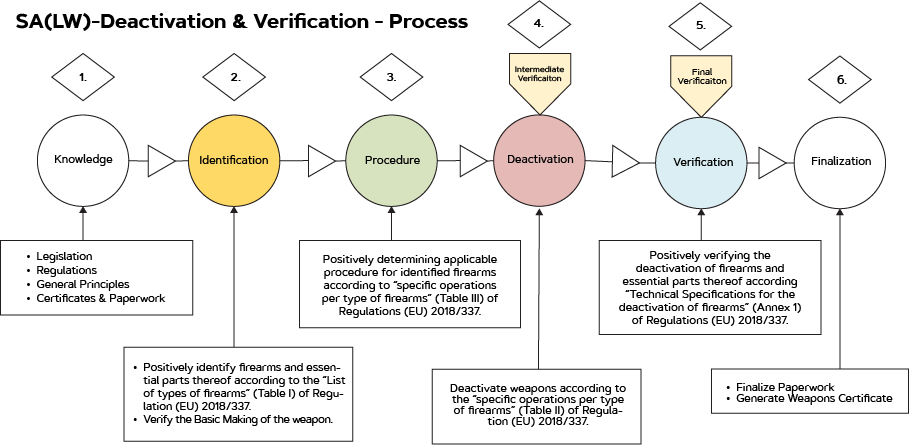
Illustration of the deactivation process. Courtesy of EUFOR MTT.
The next part of this second deactivation course consisted of a one-week program (identical to the first deactivation course) involving eleven participants from AFBiH. Due to the diligent work and preparation of the selected AFBiH trainers who conducted most of the lectures and the practical exercises, a further seven students were certified as deactivation qualified specialists. Moreover, an additional six new potential trainers were identified and designated to take part in the course planned for November 2022. However, despite the concerted efforts of the EUFOR MTT and the Norwegian instructors, the Swiss technical experts, and the students and trainers from AFBiH, both the November course and the following course planned for June 2023 had to be postponed due to AFBiH’s internal affairs.
The next course is scheduled to take place in November 2023 and an additional three courses will likely be conducted in 2024, thus ensuring that AFBiH is independently able to deactivate firearms in accordance with international standards in the future through a sustainable pool of certified deactivation qualified specialists and trainers as well as personnel certified to verify regulatory deactivation procedures.
Conclusion
Through common goals and particularly advantageous intergovernmental and organizational cooperation, it has been possible to utilize available resources regardless of national or organizational affiliations. This cooperation has included both bilateral agreements (Norway–Switzerland) within the framework of an apolitical, informal, and multinational assembly of like-minded states (MSAG) and nongovernmental organizations (NGOs) (e.g., HALO and NPA), conducted under the EU’s Common Security and Defence Policy (CSDP) mission; EUFOR’s Operation ALTHEA.
The course program has proven to be a success in terms of capability building in relation to AFBiH. By confirming that future firearm deactivation is executed according to international standards and regulations, it ensures that deactivated firearms are rendered irreversibly inoperable, thus preventing them from being used as illegal weapons in illicit firearms trafficking and criminal or terrorist activities. Furthermore, this course program can easily be replicated in other countries across the region to provide a sustainable solution to the problem of illicit weapons proliferation and the diversion of reactivated firearms through cooperation, capability building, and national ownership.
 Lieutenant Colonel Geir Petter Novik is a Senior Staff Officer at the Norwegian Ministry of Defence, currently assigned to the Norwegian Defence Research Establishment. His assignments include duty as the MoDs senior representative for defence exports and material management within the Norwegian defence sector, and as a SALW-CA project manager for the Norwegian Arms Control Office. LTC Novik holds a PhD in Science and Technology from the University of Stavanger with a specialization in risk management and societal safety particularly related to unexploded ordnance and explosive remnants of war. Geir-Petter.Novik@ffi.no
Lieutenant Colonel Geir Petter Novik is a Senior Staff Officer at the Norwegian Ministry of Defence, currently assigned to the Norwegian Defence Research Establishment. His assignments include duty as the MoDs senior representative for defence exports and material management within the Norwegian defence sector, and as a SALW-CA project manager for the Norwegian Arms Control Office. LTC Novik holds a PhD in Science and Technology from the University of Stavanger with a specialization in risk management and societal safety particularly related to unexploded ordnance and explosive remnants of war. Geir-Petter.Novik@ffi.no
| Stay updated | |||

